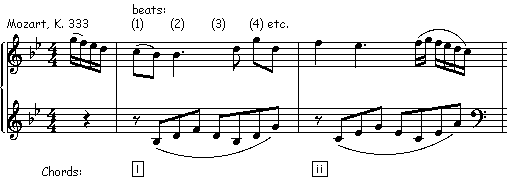Answer: Often you can't tell the difference between 2/2 and 4/4, and sometimes it may appear that the composer made the choice for no other reason than simplicity in notation (writing fast eighth notes instead of sixteenths, perhaps). However, here are some principles that would help in making a guess: 4/4 implies, of course, 4 beats per measure, and this will tend to mean more "events" in the measure. Measures in 2/2 will most often tend to divide clearly in two parts - producing a feeling of two beats. This can relate to harmonic rhythm (speed of chord changes) or to melodic accents. In this 2/2 excerpt from Mozart, for example, six of the first eight measures have two chord changes per bar, with each measure dividing nicely in half:  Most of the time the melodic accents are also only on the first and third quarter notes of each bar - if you tap your foot with this music it feels naturalto tap twice per bar.
Most of the time the melodic accents are also only on the first and third quarter notes of each bar - if you tap your foot with this music it feels naturalto tap twice per bar.
This 4/4 example from the same composer has only one chord change in each bar, but the melodic accents produced by leaps and/or dissonances produce a feeling of four events in each bar. In particular you'll notice that there's often a melodic accent on fourth quarter of the measure, as in the first full measure and the measure following - that would not be typical of 2/2

Similarly, two measures of a fast 3/4 might be confused with one measure of a slow 6/8. But a 3/4 is more likely to have a chord change or other emphasis on the third quarter - whereas a normal fast 6/8 will rarely have a chord change on the third eighth of three. The beat in 6/8 is two to a bar, counted by the dotted quarter note.

